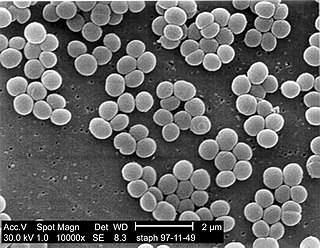Related Research Articles
The Gemmatimonadetes are a phylum of bacteria established in 2003. The phylum contains two classes Gemmatimonadetes and Longimicrobia.
Mycobacterium bolletii is a bacterial species of the phylum Actinobacteria and the genus Mycobacterium. It was named in honor of Claude Bollet, a famous clinical microbiologist and taxonomist.
Mycobacterium chubuense is a species of the phylum Actinobacteria, belonging to the genus Mycobacterium.
Mycobacterium conceptionense is a non pigmented rapidly growing mycobacterium was first isolated from wound liquid outflow, bone tissue biopsy, and excised skin tissue from a 31-year-old woman who suffered an accidental open right tibia fracture and prolonged stay in a river. Etymology: conceptionense, pertaining to Hôpital de la Conception, the hospital where the first strain was isolated.
Mycobacterium haemophilum is a species of the phylum Actinobacteria, belonging to the genus Mycobacterium.
Mycobacterium hiberniae is a species of the phylum Actinobacteria, belonging to the genus Mycobacterium.
Mycobacterium montefiorense is a species of bacteria which cause granulomatous skin disease of moray eels. Sequence analysis, of the 16S rRNA gene reveals M. montefiorense is most closely related to Mycobacterium triplex, an opportunistic pathogen of humans.
Cronobacter is a genus of Gram-negative, facultatively anaerobic, oxidase-negative, catalase-positive, rod-shaped bacteria of the family Enterobacteriaceae. They are generally motile, reduce nitrate, use citrate, hydrolyze esculin and arginine, and are positive for L-ornithine decarboxylation. Acid is produced from D-glucose, D-sucrose, D-raffinose, D-melibiose, D-cellobiose, D-mannitol, D-mannose, L-rhamnose, L-arabinose, D-trehalose, galacturonate and D-maltose. Cronobacter spp. are also generally positive for acetoin production and negative for the methyl red test, indicating 2,3-butanediol rather than mixed acid fermentation. The type species of the genus Cronobacter is Cronobacter sakazakii comb. nov.

Staphylococcus is a genus of Gram-positive bacteria in the family Staphylococcaceae from the order Bacillales. Under the microscope, they appear spherical (cocci), and form in grape-like clusters. Staphylococcus species are facultative anaerobic organisms.
Macrococcus is a genus of Gram-positive cocci belonging to the family Staphylococcaceae. The genus was created in 1998.
Nosocomiicoccus is a genus of Gram-positive cocci. The name is derived nosocomium - hospital; coccus from Greek noun kokkos - a coccus a grain, berry: Nosocomiicoccus - a coccus isolated in a hospital. The genus was erected in 2008. The genus is a member of the family Staphylococcaceae. A common feature of all members of this family is their osmo- and halotolerance - the ability to grow at high salt concentrations.
Macrococcus brunensis is a species of bacteria belonging to the genus Macrococcus.
Armatimonadetes is a phylum of gram-negative bacteria.
Staphylococcus arlettae is a gram-positive, coagulase-negative member of the bacterial genus Staphylococcus consisting of clustered cocci. It has been isolated from the skin of mammals and birds and is novobiocin resistant.
Staphylococcus equorum is a gram-positive, coagulase-negative member of the bacterial genus Staphylococcus consisting of clustered cocci. Originally isolated from the skin of healthy horses, this species contains a cell wall similar to that of Staphylococcus xylosus.
Polynucleobacter is a genus of Proteobacteria, originally established by Heckmann and Schmidt (1987) to exclusively harbor obligate endosymbionts of ciliates belonging to the genus Euplotes.
Thermolithobacteria is a class of rod-shaped Gram-positive bacteria within phylum Firmicutes. Species within this class are thermophilic lithotrophs isolated from sediment in Calcite Springs in Yellowstone National Park. Thermolithobacter ferrireducens strain JW/KA-2(T) metabolism consists of the oxidation of hydrogen gas and reduction of ferric oxide to magnetite. Thermolithobacter carboxydivorans strain R1(T) is hydrogenic and oxidizes carbon monoxide.
Macrococcus hajekii is a species of bacteria belonging to the genus Macrococcus. Strains of this species were originally isolated from the skin of llamas.
Macrococcus canis is a Gram-positive bacterium from the genus of Macrococcus which has been isolated from the nose of a dog which had mucopurulent rhinitis in Switzerland.
Enteractinococcus lamae is a bacterium from the genus of Enteractinococcus which has been isolated from animal faeces from a Alpaca from the Yunnan Wild Animal Park in China.
References
- ↑ Mannerová, Sylva; Pantůček, Roman; Doškař, Jiří; Švec, Pavel; Snauwaert, Cindy; Vancanneyt, Marc; Swings, Jean; Sedláček, Ivo (September 2003). "Macrococcus hajekii sp. nov. and Macrococcus lamae sp. nov., from the skin of llamas". International Journal of Systematic and Evolutionary Microbiology. 53 (5): 1647–1654. doi: 10.1099/ijs.0.02683-0 . PMID 13130064.